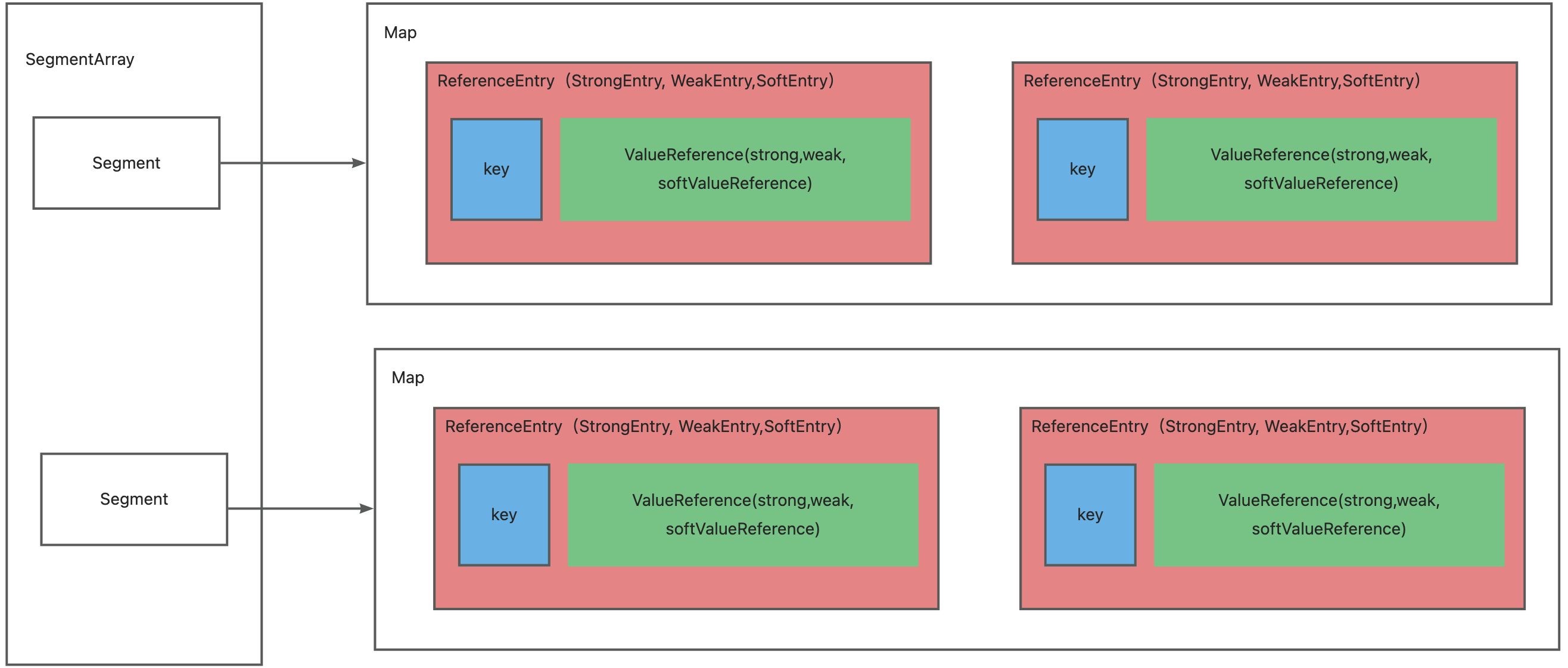Guaua Cache原理分析
·794 words·2 mins
Table of Contents
什么是LocalCache
LocalCache见名知意,就是本地缓存,通过本地缓存一些数据,提升应用程序的访问性能。其中Java中一个比较好的实现框架就是guaua的LocalCache,底层是借用了jvm的堆内存来存放数据的
特性
本地缓存的实现,其实用concurrentMap也能实现,那guaua有什么优点呢?
- 过期处理
- 自动加载
- 并发控制,最多只会有一个线程去加载数据
- 配置回收策略
- 统计命中率
使用场景
- 热点数据访问,通过多级数据缓存提升访问性能
- 本地热点数据,或者重复耗时计算的逻辑产生的数据
基本使用
//定义一个本地缓存
LoadingCache<String, Optional<String>> cache = CacheBuilder.newBuilder()
.maximumSize(1000)
.expireAfterWrite(10L, java.util.concurrent.TimeUnit.SECONDS)
.concurrencyLevel(Runtime.getRuntime().availableProcessors())
.weakKeys()
.weakValues()
.build(new CacheLoader<String, Optional<String>>() {
//重写一个CacheLoader来实现加载方法
@Override
public Optional<String> load(String key) throws Exception {
System.out.println(key+" load success");
return Optional.of("key - "+ key +" - value");
}
});
//从缓存中获取数据
try {
//get方法需要处理为null的异常
System.out.println(cache.get("key99999").orElseGet(()->"null"));
} catch (ExecutionException e) {
e.printStackTrace();
}
//不用处理异常,但是如果cache中不存在数据,不会触发加载逻辑
cache.getIfPresent("key99999");
底层原理分析
整体流程
LocalCache
LoadingCache的核心在于get,追踪get源码,会发现大部分逻辑都在LocalCache类中。
V get(K key, CacheLoader<? super K, V> loader) throws ExecutionException {
int hash = hash(checkNotNull(key));
//找到对应的segment,然后从segment中获取数据
return segmentFor(hash).get(key, hash, loader);
}
public @Nullable V getIfPresent(Object key) {
int hash = hash(checkNotNull(key));
V value = segmentFor(hash).get(key, hash);
if (value == null) {
globalStatsCounter.recordMisses(1);
} else {
globalStatsCounter.recordHits(1);
}
return value;
}
Segment
@CanIgnoreReturnValue
V get(K key, int hash, CacheLoader<? super K, V> loader) throws ExecutionException {
checkNotNull(key);
checkNotNull(loader);
try {
if (count != 0) { // read-volatile
// don't call getLiveEntry, which would ignore loading values
ReferenceEntry<K, V> e = getEntry(key, hash);
if (e != null) {
long now = map.ticker.read();
V value = getLiveValue(e, now);
if (value != null) {
recordRead(e, now);
statsCounter.recordHits(1);
return scheduleRefresh(e, key, hash, value, now, loader);
}
ValueReference<K, V> valueReference = e.getValueReference();
//如果引用对象正在加载中,等待加载完成再获取
if (valueReference.isLoading()) {
return waitForLoadingValue(e, key, valueReference);
}
}
}
//加锁获取数据
// at this point e is either null or expired;
return lockedGetOrLoad(key, hash, loader);
} catch (ExecutionException ee) {
Throwable cause = ee.getCause();
if (cause instanceof Error) {
throw new ExecutionError((Error) cause);
} else if (cause instanceof RuntimeException) {
throw new UncheckedExecutionException(cause);
}
throw ee;
} finally {
postReadCleanup();
}
}
存储结构
LocalCache 和 ConcurrentMap的区别
| 功能 | 特性 | 底层实现 | |
|---|---|---|---|
| LocalCache | 缓存 | 1. 缓存过期 2. 自动加载 3. 并发控制 4. 命中率统计 | 显式Segment分段锁机制加锁 |
| ConcurrentMap | 并发k-v存储 | 1. 并发控制 | CAS+ synchronized 对node节点加锁 |

